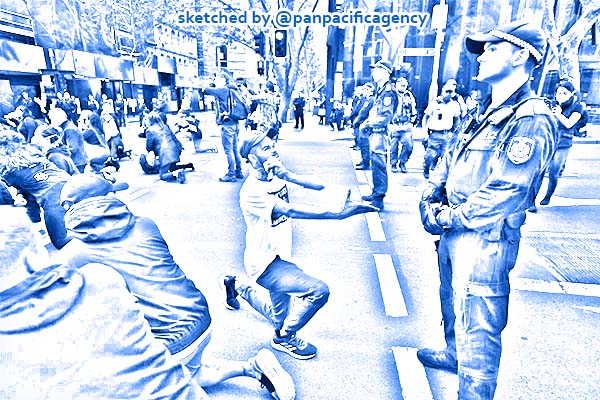60,000 people marched in Black Lives Matter demonstrations around Australia

A protester reaches out to a police officer in Sydney as a gesture of goodwill. Photo: 9News. Sketched by the Pan Pacific Agency.
LONDON, Jun 8, 2020, Daily Mail. How can 60,000 people march shoulder-to-shoulder down city streets… but weddings and funerals can be restricted to just 20, 30 or 50 people? That’s the reasonable question many are asking after Black Lives Matter protests across the nation exposed the painful contradictions in Australia’s approach to the coronavirus, Daily Mail reported.
Thousands poured onto the streets of Sydney, Melbourne and Brisbane on Saturday, in an act of defiance after months of obeying unwieldy and often devastating COVID-19 restrictions.
Taking a stand for the rights of Indigenous people, and linking arms with those protesting George Floyd’s death in the United States, was deemed essential.
But while 20,000 marched in Sydney, 30,000 in Brisbane and 10,000 in Melbourne, the shackles of our COVID-19 rules remain firmly in place.
Businesses have closed, workers lost their jobs, weddings have been cancelled, loved ones have died alone and their deaths mourned by the few permitted to say goodbye.
A grieving widow told Radio 2GB the march was ‘disgusting’ given the ‘heartwrenching’ calls she had to make to loved ones seeking to mourn her husband’s death.
‘We had to say, I’m really sorry, you can’t come (to the socially-distanced funeral),’ the widow tearfully recounted. ‘You can’t even stand in the garden.’
It was rough. And it still is. Rules vary across Australia, but funerals are still limited to 50 mourners in New South Wales, and in Victoria, 20 indoors and 30 outside. Weddings in those two states are still limited to just 20 attendees.
Meanwhile, many businesses are yet to re-open, thanks to corona rules. Gigs, cultural events and music festivals are unthinkable. Sport stands and museums will soon open to just a trickle.
Yet tens of thousands marched the streets – in some states legally, in others less so.
At the same time, those who protested at the weekend were all too aware about the risks of COVID-19.
In Sydney, the air smelt of hand sanitiser.
The majority of protesters wore face masks – a scene once alien to Australia.
The cause – to shine a spotlight on Indigenous deaths in custody and make a stand against racism – was noble.
But what chafes the most, and has outraged many, is that the demonstration showed Australia’s coronavirus rules are clearly inconsistent.
The confusion and double standards come from the top down.
Just last week, New South Wales Premier Gladys Berejiklian said the demonstration could go ahead.
‘Protesting is an inherent right in our democracy and I ask anybody who is considering to do that, to do it peacefully and to maintain a social distance from other people,’ she said.
‘You might actually be in a place where there’s lots of other people around, lots of other groups around. That’s okay so long as you manage social distancing.’
Days later, after rebellion in her own ranks, Ms Berejiklian changed her tune.
She even had the gumption to claim the NSW government would ‘never ever give the green light to thousands of people flagrantly disregarding the health orders’.
And how can Prime Minister Scott Morrison tell the community it’s time to ‘get out from under the doona’ – and write off smaller protests as a sign of a ‘free country’ – then watch as his ministers rubbish a protest as ‘reckless, irresponsible and self-indulgent’?
Authorities said on Monday that we should know in a fortnight whether there has been a ‘Black Lives Matter’ outbreak, or if the virus’s transmission in the community really is as low as hoped.
Victorian deputy chief health officer Annaliese van Diemen said: ‘It really will be at least a week and probably closer to two weeks before we have an idea of whether there’s been any transmissions or outbreaks related to that.’
As of this afternoon, there were fewer than 460 active cases across Australia.
Seven in 10 cases across the past week were acquired overseas, in a very positive development.
Whether there is protest cluster will the ultimate test of whether Australia is ready to cast aside the most onerous of COVID restrictions.
If 60,000 Australians can go out and exercise one of their most important rights, without the horror of another COVID outbreak, surely the rest of us can begin to take the shackles off and get the economy moving?
We’ll know by June 20.